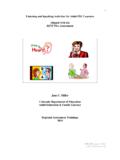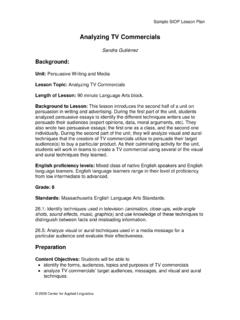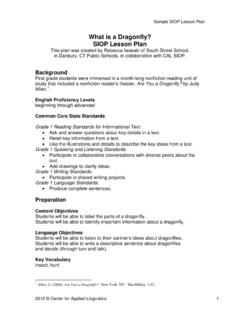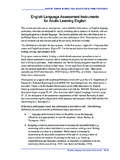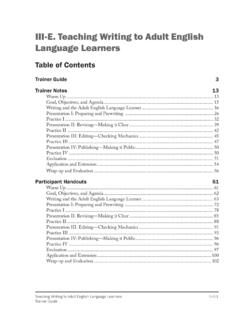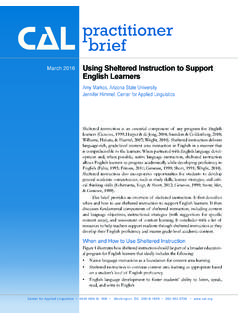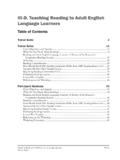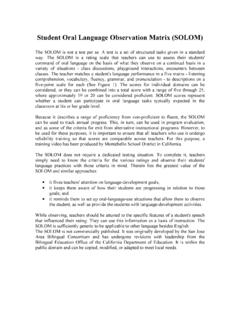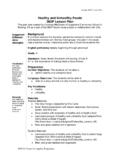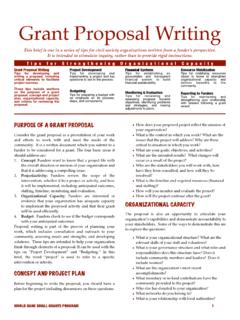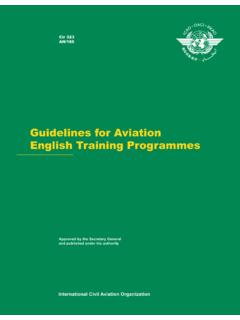Transcription of Activities to Promote Reading Development
1 _____ PART II: ACTIVITY PACKETS Activities to Promote Reading Development II 57 Activities to Promote Reading Development Adult English language learners come from diverse backgrounds and have widely differing literacy experiences in their first languages. A number of factors influence the ways their English literacy develops and the progress they make in learning to read English. These factors include level of literacy in their first language and in English, oral language proficiency in English, educational background, personal goals for learning English, and the structure and writing system of their first language. These factors must be taken into account in all areas of program planning, learner placement in classes, and instructional approaches. This section looks at types of native language literacy and the Reading process. What Types of Native Language Literacy Might Learners Have?
2 Six types of first language literacy can be described: preliterate (learners come from cultures where the native language is not written or is in the process of being written); nonliterate (learners come from cultures where literacy is available, but they have not had sufficient access to literacy, often because of their socio-economic or political status); semiliterate (learners have had access to literacy in their native culture, but because of their socio-economic status or political or educational situation, they have not achieved a high level of literacy in their native language); non-alphabet literate (learners are literate in a language with a non-alphabetic script [ , Chinese or Japanese]); non-Roman alphabet literate (learners are literate in a language with a non-Roman alphabetic script [ , Arabic, Greek, Korean, Russian, or Thai]); and Roman-alphabet literate (learners have literacy in a language such as French, Italian, or Croatian, which use the same alphabet as English).
3 Teachers need to know the type and amount of literacy learners have in their native language, because this will affect the rate and the way in which they learn to read in English. What Do Learners Need to Know to Read English? Researchers working with adult English language learners have focused primarily on the following component skills of Reading Development : phonological processing, vocabulary knowledge, syntactic processing, and background knowledge. (See English Language and Literacy Learning: Research to Practice, page IV 1, for discussion.) Phonological processing (or decoding) involves interpreting written letters as sounds and combining letters correctly into words. This skill includes awareness of individual speech sounds and the ways they are represented in print, and the way that language is represented in print by letters, words, syllables, and word breaks. For example, in the sentence My sister bought a new dress, the sound /b/ in the word bought is represented by the letter b and the sound /a/ is represented by the letters ough; sister divides into two syllables sis/ter; and the sentence is composed of six discrete words.
4 PART II: ACTIVITY PACKETS _____ II 58 Activities to Promote Reading Development Vocabulary knowledge has been found to have a strong effect on Reading comprehension. The components of vocabulary knowledge include breadth (the number of words a learner knows) and depth (the amount of knowledge a learner has about a specific word). Breadth of vocabulary knowledge is important to English language learners, as they frequently know far fewer English words than native speakers and find themselves at a disadvantage, particularly in academic contexts (Folse, 2004; Qian, 1999). Depth of word knowledge includes knowing how to pronounce and spell the word; what the root of the word is, whether there are prefixes or suffixes attached to the word, and what part of speech the word is; how the word is used in sentences; what connotations the word has; whether there are multiple meanings of the word; and in what contexts the word is used.
5 For example, deep knowledge of the word rider means knowing how to spell the word, knowing that the i is pronounced /ay/, knowing that the word is a person or thing (a noun), knowing that because the word has the suffix er it refers to a person or thing that rides, and knowing that the word might appear in a sentence such as There was no rider on the horse. Deeper knowledge of the word means knowing that rider has other meanings, and that another fairly common use of the word is to refer to an additional clause or piece of legislation that is attached to another bill without being related to the original piece of legislation. Still deeper knowledge of the word would mean knowing that in this case, the connotation of the word may be somewhat negative, as can be seen in the sentence The senator was famous for adding riders that were unrelated to the bills to which they were attached, but which would bring industry and money to his state.
6 Syntactic processing involves understanding the structures of the language and making connections among words in a sentence or sentences in a text. For example, learners need to learn the forms that signal different word meanings ( , -ed form of verbs to denote past tense and passive voice), forms that change word meanings ( , prefixes such as non, in, im, and un that make words negative, and words that bring cohesion to a text ( , however, therefore, nevertheless). Background knowledge facilitates Reading comprehension. Readers generally understand texts more easily if they are familiar with the topics covered and the genres and text structures involved. Especially for beginning-level readers, readings about culturally familiar topics should be selected, and teachers should build on ideas and concepts from learners cultures and personal experiences whenever possible. For example, prior to Reading about schooling in the United States, the teacher might ask learners about schooling in their home countries, what ages children go to school, how classes are divided, and what kind of testing or assessment is used.)
7 The teacher might then move to a discussion of what the students know about schooling in the United States, asking similar questions. Important vocabulary words (especially those in the Reading ) such as grades, assessment, testing, classes, can be written on the board as they come up during the pre- Reading discussion. _____ PART II: ACTIVITY PACKETS Activities to Promote Reading Development II 59 Reading Lessons The four Reading components described are integrated into a Reading lesson, but they may not all be practiced in any one day. A Reading lesson may cover several class periods. Throughout the lesson, the teacher should be aware of gaps in the learners skills and plan Activities that give them the practice they need. For example, if students are having difficulties comprehending past tense verbs in a Reading , the teacher would then include Activities to practice using -ed to form past tense (syntactic processing); if students demonstrate difficulties in pronouncing the past tense marker, the teacher could then include Activities to practice the pronunciations of -ed (phonological awareness).
8 The following Activities give examples of Reading Activities that can be used with learners who are preliterate, those who have minimal Reading skills in any language, and those who have some literacy in English. As always, it is up to teachers to adapt the Activities for use with the learners in their classes. Sample Set II 30: Techniques for Teaching Reading to Beginning Literacy Learners Sample Set II 31: Techniques for Teaching Vocabulary Sample II 32: Beginning Reading Lesson Plan Sample II 33: Multilevel Reading Lesson Plan References Burt, M., & Peyton, J. K. (2003). Reading and adult English language learners: The role of the first language. Washington, DC: Center for Applied Linguistics. Retrieved December 14, 2004, from Burt, M., Peyton, J. K., & Adams, R. (2003). Reading and adult English language learners: A review of the research Washington, DC: Center for Applied Linguistics.
9 Available from Folse, K. S. (2004). Vocabulary myths: Applying second language research to classroom teaching. Ann Arbor: The University of Michigan Press. Kruidenier, J. (2002). Research-based principles for adult basic education Reading instruction. Retrieved June 18, 2004, from html/adult_ed/ Qian, D. D. (1999). Assessing the roles of depth and breadth of vocabulary knowledge in Reading comprehension. The Canadian Modern Language Journal, 56, 262-305. PART II: ACTIVITY PACKETS _____ II 60 Activities to Promote Reading Development Sample Set II 30: Techniques for Teaching Reading to Beginning Literacy Learners Pre-literacy Reading Readiness Skills Development : Pre-alphabetics Adult English language learners who have little or no literacy in English may have little or no literacy ability in their native language. They may come from countries that have no written alphabet, or where an alphabet is just being developed, such as with Somali Bantu.
10 If there is a written tradition in their country, the alphabet may be written from right to left, as is the Arabic alphabet; or the writing may not be alphabetic, as with Chinese languages (Burt, Peyton, & Adams, 2003). This means that, before they can receive instruction in alphabetics skills including phonological processing and decoding, learners may need to develop pre-literacy concepts and skills. These include distinguishing same and different objects and shapes, how to hold a pencil and paper, copying shapes and patterns, and understanding directionality ( , top, bottom, left, and right). Distinguishing same and different objects a. Hold the same ordinary object in each hand ( , pen or cup). Say, These are the same. Have the students repeat same several times. b. Hold one object in one hand and another in the other ( , pencil in one and book in the other). Say, These are different.

